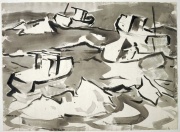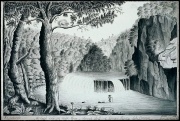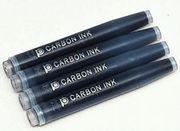Difference between revisions of "Carbon-based ink"
(username removed) |
|||
| (13 intermediate revisions by 4 users not shown) | |||
| Line 1: | Line 1: | ||
| − | [[File:1996.322-SC19978.jpg|thumb|]] | + | [[File:1996.322-SC19978.jpg|thumb|Black wash over graphite<br>MFA# 1996.322]] |
== Description == | == Description == | ||
| + | [[File:50.3888-115-34.jpg|thumb|Black ink and wash <br>MFA# 50.3888]] | ||
| + | A black ink containing powdered [[carbon]] pigment. Carbon-based inks can contain [[lampblack]] (soot) in water (see([[India ink]]). However using a dilute aqueous solution of [[gum]] or [[glue]] can provide more durability after drying. Additionally, the binder, pigment mixture can be dried into a dish or block and later activated with a drop of water or wet brush. Carbon inks have a deep black color that is very stable. They were used in China as early as the 3rd millennium BCE (Kuhn 1986). They were also used by ancient Egyptian for writing and drawing on papyrus, wood, potsherds and other materials They were used in Europe on medieval manuscripts, but later replace with [[iron gall ink| Iron gall inks]]. Carbon-based ink are available today in similar dry or aqueous formulations. Waterproof carbon-based inks containing shellac have also been used in old formulations, but modern waterproof carbon black inks contain synthetic varnishes. Hebborn (1997) indicates that the best current option for Chinese ink comes from China in small sticks wrapped in rice paper. | ||
| − | + | [[File:image2_carbonink.jpg|thumb|Carbon Ink]] | |
| − | |||
| − | [[File: | ||
== Synonyms and Related Terms == | == Synonyms and Related Terms == | ||
| − | carbon black ink; Chinese ink; Indian ink; | + | carbon black ink; carbon ink; black wash Chinese ink; Indian ink; India ink (Br.) |
| − | |||
| − | |||
| − | |||
| − | |||
| − | |||
| − | |||
| − | |||
| − | |||
| − | |||
| − | |||
| − | |||
| − | |||
| − | |||
| − | |||
| − | |||
| − | |||
| − | |||
| − | |||
| − | |||
| − | |||
| − | * | + | ==Physical and Chemical Properties== |
| + | * Does not fade. | ||
| + | * Soluble in water. | ||
| − | + | ==Resources and Citations== | |
| − | |||
| − | |||
| + | * G.S.Brady, ''Materials Handbook'', McGraw-Hill Book Co., New York, 1971 Comment: p. 410 | ||
| + | * Hermann Kuhn, ''Conservation and Restoration of Works of Art and Antiquities'', Butterworths, London, 1986 | ||
| + | * Matt Roberts, Don Etherington, ''Bookbinding and the Conservation of Books: a Dictionary of Descriptive Terminology'', U.S. Government Printing Office, Washington DC, 1982 | ||
| + | * Book and Paper Group, ''Paper Conservation Catalog'', AIC, 1984, 1989 | ||
* ''A Glossary of Paper Conservation Terms'', Margaret Ellis (ed.), Conservation Center of the Institute of Fine Arts, New York City, 1998 | * ''A Glossary of Paper Conservation Terms'', Margaret Ellis (ed.), Conservation Center of the Institute of Fine Arts, New York City, 1998 | ||
| − | |||
* Art and Architecture Thesaurus Online, http://www.getty.edu/research/tools/vocabulary/aat/, J. Paul Getty Trust, Los Angeles, 2000 | * Art and Architecture Thesaurus Online, http://www.getty.edu/research/tools/vocabulary/aat/, J. Paul Getty Trust, Los Angeles, 2000 | ||
| − | + | * Wikipedia: [https://en.wikipedia.org/wiki/India_ink India ink] Accessed March 2025 | |
| − | + | * Eric Hebborn, ‘The Art Forger’s Handbook’ The Overlook Press,Woodstock, NY 1997. | |
[[Category:Materials database]] | [[Category:Materials database]] | ||
Latest revision as of 15:23, 25 March 2025
Description
A black ink containing powdered Carbon pigment. Carbon-based inks can contain Lampblack (soot) in water (see(India ink). However using a dilute aqueous solution of Gum or Glue can provide more durability after drying. Additionally, the binder, pigment mixture can be dried into a dish or block and later activated with a drop of water or wet brush. Carbon inks have a deep black color that is very stable. They were used in China as early as the 3rd millennium BCE (Kuhn 1986). They were also used by ancient Egyptian for writing and drawing on papyrus, wood, potsherds and other materials They were used in Europe on medieval manuscripts, but later replace with Iron gall inks. Carbon-based ink are available today in similar dry or aqueous formulations. Waterproof carbon-based inks containing shellac have also been used in old formulations, but modern waterproof carbon black inks contain synthetic varnishes. Hebborn (1997) indicates that the best current option for Chinese ink comes from China in small sticks wrapped in rice paper.
Synonyms and Related Terms
carbon black ink; carbon ink; black wash Chinese ink; Indian ink; India ink (Br.)
Physical and Chemical Properties
- Does not fade.
- Soluble in water.
Resources and Citations
- G.S.Brady, Materials Handbook, McGraw-Hill Book Co., New York, 1971 Comment: p. 410
- Hermann Kuhn, Conservation and Restoration of Works of Art and Antiquities, Butterworths, London, 1986
- Matt Roberts, Don Etherington, Bookbinding and the Conservation of Books: a Dictionary of Descriptive Terminology, U.S. Government Printing Office, Washington DC, 1982
- Book and Paper Group, Paper Conservation Catalog, AIC, 1984, 1989
- A Glossary of Paper Conservation Terms, Margaret Ellis (ed.), Conservation Center of the Institute of Fine Arts, New York City, 1998
- Art and Architecture Thesaurus Online, http://www.getty.edu/research/tools/vocabulary/aat/, J. Paul Getty Trust, Los Angeles, 2000
- Wikipedia: India ink Accessed March 2025
- Eric Hebborn, ‘The Art Forger’s Handbook’ The Overlook Press,Woodstock, NY 1997.


